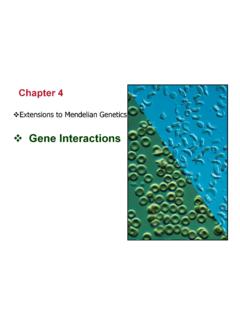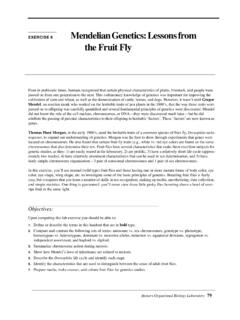Transcription of Unit 18: Genetics and Genetic Engineering - Edexcel
1 Edexcel BTEC Level 3 Nationals specification in Applied Science Issue 1 January 2010 Edexcel Limited 20091 Unit 18: Genetics and Genetic EngineeringUnit code: T/502/5559 QCF Level 3: BTEC NationalCredit value: 10 Guided learning hours: 60 Aim and purposeThe aim of this unit is to develop understanding of the principles of Mendelian Genetics and to develop knowledge and practical techniques used in commercial, analytical and research laboratories. Unit introductionTo study Genetics is to study the basis of life itself. Building on the knowledge of DNA structure which is covered in the Biochemistry and Biochemical Techniques unit, this unit will enable learners to appreciate that genes control all of the characteristics of living organisms. Learners will also understand how the mechanisms of cell division and chromosome replication lead to complex patterns of inheritance and evolution.
2 Massive advances in DNA technology over the last 20 years mean that molecular biology and Genetics are central in fields as diverse as forensics, epidemiology, screening for diseases and archaeology. The tools and the knowledge now available allow manipulation of the blueprints of life and the creation of novel organisms. Current research is moving towards gene therapies which may enable correction of Genetic diseases such as cystic fibrosis. Learners will develop an understanding of the techniques at the heart of modern Genetics and molecular biology extracting DNA, DNA fingerprinting, transforming cells and amplifying DNA using the polymerase chain reaction (PCR).The cutting edge of Genetics is moving forward at an extraordinary rate, creating enormous potential for applications.
3 Geneticists can be found in many fields of forensic work, in epidemiology, in screening for diseases and in searching for cures. The ever-growing biotechnology industry depends heavily on the work of geneticists and molecular biologists to provide both new products and the means to mass-produce them. Applications of Genetics in agriculture include modified crops with enhanced nutritional value, flavour, shelf-life or resistance to pests and disease. Environmental applications allow us to map migration of species and populations, and to identify animals illegally taken from the must also recognise the broader implications of their work. Learners are required to examine the impact of selected examples of Genetic technology on industry, society and the ethical values of individuals and BTEC Level 3 Nationals specification in Applied Science Issue 1 January 2010 Edexcel Limited 20092 Learning outcomesOn completion of this unit a learner should:1 Understand the process of protein synthesis2 Be able to investigate the process of cell division in eukaryotic cells3 Understand the principles of Mendelian genetics4 Be able to apply basic techniques of DNA BTEC Level 3 Nationals specification in Applied Science Issue 1 January 2010 Edexcel Limited 2009 Unit content1 Understand the process of protein synthesisStructure of nucleic acids: DNA; RNA; mRNA; tRNAS tages: transcription.
4 Translation; amino acid activationGenetic code: triplet codes; codon; anticodon; degenerate code2 Be able to investigate the process of cell division in eukaryotic cellsStructure and function of the human chromosome: centromere; chromatids; autosomes; sex chromosomes; chromosome number; homologous and non-homologous chromosomesCell division: the cell cycle; interphase; stages of mitosis and meiosis, centrioles, cytokinesis (in animal cells); diploid/haploid numbers; sex determinationDemonstrate: root tip squash to demonstrate mitosis; lily anther squash to demonstrate meiosis3 Understand the principles of Mendelian geneticsPrinciples of classical Genetics : Mendel s laws of inheritance, Mendelian ratios; principle of independent assortment; interpretation of mono and dihybrid phenotypic ratios from practical investigation from primary or secondary source information; continuous and discontinuous variation; effects of environmental changesModern Genetics : genes; genotype; alleles; dominance and codominance; linkage; sex linkage eg haemophilia; chromosome mutation eg Down s syndrome; dominant and recessive disorders eg Huntington s disease, sickle cell anaemia, cystic fibrosis4 Be able to apply basic techniques of DNA technologyDNA extraction: chromosomal or plasmidsGel electrophoresis of DNA fragments: use of restriction enzymes; principles of electrophoresisTransformation of cells: use of vectors; plasmids; use of marker genes; DNA ligase.
5 Screening to identify transformed cellsAmplification of DNA: polymerase chain reaction and its applicationsExamples of Genetic Engineering : GM crops; gene therapy; insulin and human growth hormone production; impact eg commercial, social, ethicalEdexcel BTEC Level 3 Nationals specification in Applied Science Issue 1 January 2010 Edexcel Limited 20094 Assessment and grading criteriaIn order to pass this unit, the evidence that the learner presents for assessment needs to demonstrate that they can meet all the learning outcomes for the unit. The assessment criteria for a pass grade describe the level of achievement required to pass this and grading criteriaTo achieve a pass grade the evidence must show that the learner is able to:To achieve a merit grade the evidence must show that, in addition to the pass criteria, the learner is able to:To achieve a distinction grade the evidence must show that, in addition to the pass and merit criteria, the learner is able to:P1 compare and contrast the structure of various nucleic acids [IE1; CT2]M1 explain how Genetic information can be stored in a sequence of nitrogenous bases in DNA D1 explain the steps involved in biosynthesis of protein including the roles of RNAP2 identify the stages of mitosis and meiosis in eukaryotic cells [IE1.]
6 CT2]M2 describe the behaviour of chromosomes during cell division using the results of the practical investigationsD2 analyse the correlation between observed pattern of dihybrid inheritance and the expected pattern P3 carry out practical investigations to record stages of cell division [IE2; TW1; SM2; EP3]P4 explain how the behaviour of chromosomes leads to variation [IE4]M3 apply principles of modern Mendelian Genetics to predict patterns of monohybrid, dihybrid inheritance and variationP5 explain monohybrid and dihybrid inheritance ratios [IE4]P6 carry out basic DNA techniques [IE2; TW1; SM2; EP3]M4 describe digestion of DNA by restriction endonucleases and electrophoresis of explain the steps involved in producing a genetically modified identify applications of Genetic Engineering .
7 [IE1]PLTS: This summary references where applicable, in the square brackets, the elements of the personal, learning and thinking skills applicable in the pass criteria. It identifies opportunities for learners to demonstrate effective application of the referenced elements of the independent enquirersCT creative thinkersRL reflective learners TW team workersSM self-managersEP effective participators5 Edexcel BTEC Level 3 Nationals specification in Applied Science Issue 1 January 2010 Edexcel Limited 2009 Essential guidance for tutorsDeliveryA visit to an industrial state-of-the-art laboratory is strongly recommended. Learners should appreciate the sophistication of modern-day high-tech laboratories compared with the basic equipment available in educational laboratories.
8 Differences include the analytical machinery which is in common use, multiple transfer conditions, the clear demarcation of clean and contaminated areas (not only in biological and animal laboratories, but even in many chemistry ones) and the separate space for computers, desks etc that learners may not be aware unit is intended to have a practical element, and it would benefit learners to carry out practical work in both Mendelian and molecular Genetics . For learning outcome 1, learners should show their understanding of the structure and function of the DNA molecule and use this as a basis to describe the process of protein synthesis. They must emphasise the role of nitrogen base pairing and sequence in relation to the storage of learning outcome 2, which involves the study of cell division, it would be preferable for learners to complement practical activities using root tips and other preparations, with electronic simulations.
9 Learners are expected to be able to use microscopes competently and should have the opportunity to carry out a practical examination of both forms of cell division. Mitosis in a garlic or onion tip would be a straightforward practical, with the anther or locust testis squash for meiosis. In learning outcome 3, inheritance in Drosophila melanogaster can be investigated using quite affordable kits from suitable suppliers and does not require any specialist equipment beyond an incubator. If that is deemed impractical, enough data to allow a chi-squared analysis can be gathered from counts using sources such as corn cob sets. Chi-squared analysis can be carried out using a spreadsheet if desired. Alternatively, electronic simulations can be found on CD ROM or by online subscriptions to facilities such as Virtual learning outcome 4, the basic techniques of DNA technology are now quite easy to demonstrate in simplified form in the laboratory.
10 DNA can be extracted from plant tissue very simply, and kits are available for extraction of DNA from cheek cells. Protocols for DNA or plasmid extraction, gel electrophoresis and cell transformation can be obtained from sources such as the National Centre for Biotechnology Education at the University of Reading, and Bio-Rad. These protocols are designed to be affordable within the resources of schools and colleges. The polymerase chain reaction can be carried out manually using water baths. While this is a laborious process, it gives the learners a clearer picture of the steps involved in the process than a PCR machine BTEC Level 3 Nationals specification in Applied Science Issue 1 January 2010 Edexcel Limited 20096 Outline learning planThe outline learning plan has been included in this unit as guidance and can be used in conjunction with the programme of suggested outline learning plan demonstrates one way in planning the delivery and assessment of this unit.















